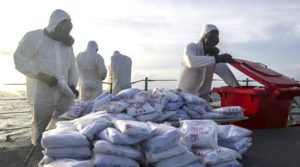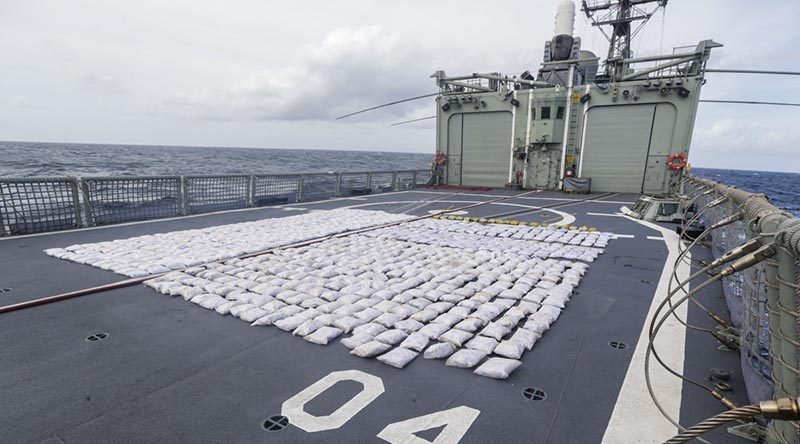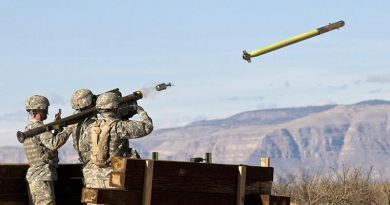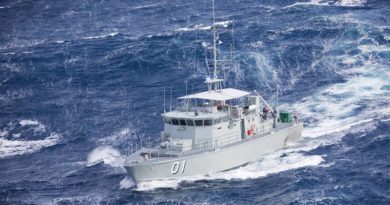HMAS Darwin seizes 952kg of heroin – but Defence flunks maths
Share the post "HMAS Darwin seizes 952kg of heroin – but Defence flunks maths"

HMAS Darwin has seized approximately 952kg of heroin during three consecutive vessel interceptions off the coast of Africa.
According to Defence, “The total haul has a value of close to AUD $800 million” – though CONTACT has some issues with this and other figures previously reported by Defence (see below).
Defence says that with the support of a Combined Maritime Force (CMF) surveillance aircraft, Darwin conducted its first boarding on 21 May, which yielded 380kg of drugs after a thorough search of the vessel.
Then, Darwin’s helicopter identified a further two suspicious vessels on 22 May and 25 May with subsequent boardings revealing 512kg and 60kg of drugs respectively.

All the drugs seized were transferred to Darwin for testing and confirmed as heroin, before being destroyed.
Commander Phillip Henry, Commanding Officer Darwin, praised the work of his ship’s company during this busy patrol.
“Traffickers constantly try to find new ways to hide cargo, but our boarding parties’ training, techniques and equipment evolve and we continue to find and dispose of seriously large quantities of illicit goods,” he said.
“The best part about our involvement in these operations is that we are able to remove a significant portion of funding from terrorist organisations.
“With the help of our CMF partners, both at sea and ashore, we have had tremendous success in tracking down suspicious vessels and uncovering drugs hidden away on several of them.
Chief of Joint Operations Vice Admiral David Johnston acknowledged the great work of Darwin’s ship’s company in these latest seizures – and CONTACT echos that praise.
“Darwin’s combined efforts under CTF-150 is a good example of how we are improving the overall maritime security, stability and prosperity in the region by denying terrorist organisations their ability to move personnel, weapons or drugs, and obstructing their capacity to raise funds,” he said.
“These seizures take the Royal Australian Navy’s total of narcotics interdicted to more than four tonnes*[see notes below] since the start of Operation MANITOU,” VADM Johnston said.
Darwin‘s seized drugs were disposed of at sea in accordance with Australian policy.
HMAS Darwin has completed her fourth patrol under Operation MANITOU – the Australian Government’s contribution to the multinational CMF and CTF-150 efforts.
HMAS Darwin is on her 7th deployment to the Middle East Region, and it is the 62nd rotation of a Royal Australian Navy vessel in the region since 1990..
.
.
CONTACT praises the efforts of the men and women aboard HMAS Darwin and all other Royal Australian Navy ships who have done brilliant work in the Middle East over many years – and we’d hate for nitpicking to tarnish that record – but…
In the story above, there are just two numbers (and no qualifying remarks) listed – namely, that 952kg of heroin was seized and that heroin is valued at AUD$295,000/kg by the Australian Crime Commission Annual Report 2013-2014.
Using a simple calculator, we put the value of this recent haul at $280,840,000 – not “close to AUD $800 million”.
CONTACT asked Defence for an explanation and was told “The ADF provided a drug value figure in its recent release that is based on the Australian Crime Commission (ACC) Report 2013-2014 and was adjusted to reflect the purity of the heroin.”
This last bit in red was not included in this or any other press release to date.
CONTACT cited this story from June 2015, which says HMAS Newcastle landed “1.3 tonnes of heroin valued at approximately $1.114 billion” – which suggests that, at that time, Defence valued the drugs at almost $857,000/kg.
And this story from September 2015 puts HMAS Newcastle’s eventual total haul at 1525kg of narcotics, with a ‘conservative’ street-value of more than $1.222 billion, which re-values the haul at $801,000/kg.
Here’s another thing – in the aforementioned December 2015 story, HMAS Melbourne was said to have hauled 216kg of high-grade heroin, which was valued at $64 million – or $296,000/kg – and the total to that time of 5 tonnes was valued at $664 million, or $132,800/kg (which was obviously re-valued, because Melbourne’s first 853kg of heroin, reported in February 2014, was valued at $1.7billion)
So, if HMAS Melbourne’s later haul was high grade and valued consistent with the Australian Crime Commission’s valuation, why are other ship’s hauls adjusted to reflect the purity of the heroin – and how can that purity be valued nearly three times higher than Melbourne’s high-grade heroin?
Defence says, “for consistency of Australian reporting, since July 2014 drug values have been calculated using the ACC Report 2013-2014″ [bold and colour for emphasis].
But, if consistency is the key, why is one ship reporting values largely consistent with the ACC Report and subsequent ships reporting purity variations that are inconsistent and never quantified – all while citing the ACC figures but never mentioning purity?
We also pointed out that in the recent release, Vice Admiral David Johnston is quoted as saying Darwin’s haul this month brings the total of narcotics interdicted to more than four tonnes, but this December 2015 story says, “The seizure takes the Royal Australian Navy’s narcotics haul since February 2014 to over 5 tonnes”.
In response, Defence said, “The figure of four tonnes refers to the total haul of heroin since the beginning of Operation MANITOU which began in 2014” [they didn’t say which month]. In other words, Defence has jumped from quoting ‘total haul’ to ‘total Op MANITOU haul’ without warning or explanation, and eliminating Melbourne’s early successes.
That said, we note that some of the pre-July 2014 quoted values for drugs were just insane. For example, HMAS Melbourne lifted 353kg of “what is believed to be heroin” in February 2014. In other words, they weren’t sure enough it was heroin to say for sure it was heroin (and therefore couldn’t cite a reasonable variation for purity) – but went ahead and valued it at $706 million – or $2million/kg!
In CONTACT’s opinion, Defence’s explanations/arguments around what should be straightforward, consistent, pure figures would be shot to shit in any court of law.
But, of course, this is not a court of law.
I’m just a cranky old reporter trying to report true and accurate facts to my audience (who probably don’t give a rat’s arse anyway).
And my issue in all of this isn’t with the drugs or their value. My issue is with credibility.
My argument is, if I can’t trust Defence to report consistently and accurately on things that should have a clear, clean reporting line – figures I should be able to easily fact-check with a calculator – how can I (or any of us) trust them to report consistently, accurately and honestly on the things we can’t fact check.
The bottom line is, while CONTACT absolutely supports and praises the men and women doing the hard yards on the front line, we have increasing difficulty taking the ADF’s own reporting of events seriously when they can’t even get simple maths right.
.
For the record, here is the full transcript of Defence’s response to my initial criticisms (which have been amended and expanded in light of the following)…
“The ADF provided a drug value figure in its recent release that is based on the Australian Crime Commission (ACC) Report 2013-2014 and was adjusted to reflect the purity of the heroin.
The drug values in previous ADF media releases were initially calculated on UNODC drug values. However, for consistency of Australian reporting, since July 2014 drug values have been calculated using the ACC Report 2013-2014.
The figure of four tonnes refers to the total haul of heroin since the beginning of Operation MANITOU which began in 2014. Prior to Operation MANITOU, the Royal Australian Navy has undertaken counter-narcotic operations in the Middle East Region as part of Operation SLIPPER. Drugs seized during this operation were historically calculated using UNODC values.”
.
..
.
.
.
.
.

.
.
Share the post "HMAS Darwin seizes 952kg of heroin – but Defence flunks maths"







The drugs seized by HMAS DARWIN are high purity (74-80% pure), which are ‘cut’ – by a factor of 3, commonly – to a much more diluted level for street distribution. Hence the higher value for the greater quantity of ‘cut’ heroin sold on the streets. [This is not made explicit in the press release because, sadly, most readers are not interested in the background maths.]
I hear what you’re saying John – but that argument doesn’t work when they specifically said 952kg and that the “Figure for value of haul is calculated on the Australian Crime Commission Report 2013-2014. One kilogram of heroin equates to approximately AUD $295000.”